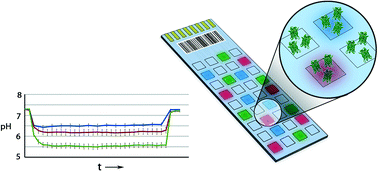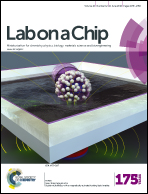An electrochemical platform for localized pH control on demand†
Abstract
Solution pH is a powerful tool for regulating many kinds of chemical activity, but is generally treated as a static property defined by a pre-selected buffer. Introducing dynamic control of pH in space, time, and magnitude can enable richer and more efficient chemistries, but is not feasible with traditional methods of titration or buffer exchange. Recent reports have featured electrochemical strategies for modifying bulk pH in constrained volumes, but only demonstrate switching between two preset values and omit spatial control entirely. Here, we use a combination of solution-borne quinones and galvanostatic excitation to enable quantitative control of pH environments that are highly localized to an electrode surface. We demonstrate highly reproducible acidification and alkalinization with up to 0.1 pH s−1 (±0.002 pH s−1) rate of change across the dynamic range of our pH sensor (pH 4.5 to 7.5) in buffered solutions. Using dynamic current control, we generate and sustain 3 distinct pH microenvironments simultaneously to within ±0.04 pH for 13 minutes in a single solution, and we leverage these microenvironments to demonstrate spatially-resolved, pH-driven control of enzymatic activity. In addition to straightforward applications of spatio-temporal pH control (e.g. efficiently studying pH-dependencies of chemical interactions), the technique opens completely new avenues for implementing complex systems through dynamic control of enzyme activation, protein binding affinity, chemical reactivity, chemical release, molecular self-assembly, and many more pH-controlled processes.


 Please wait while we load your content...
Please wait while we load your content...